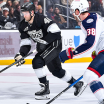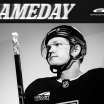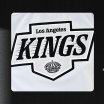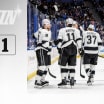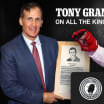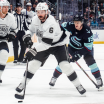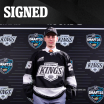Dave Taylor was the first NHL player I had ever met. I was seven years old. Although I wasn't an LA Kings fan growing up, I knew exactly who he was.
Taylor was from the same tiny mining town in Northern Ontario as my father and the two of them went to the same high school. While Taylor was a few years older than my dad, they would have crossed paths. That connection had always meant something to me.
Every summer when we would go visit my grandparents in Onaping, a stone's throw away from where Taylor grew up in Levack, I was reminded that this, too, was where he spent his formative years. The idea that I was playing on the same roads and swimming in the same lakes as he did when he was younger was special to me.
From Levack to LA: Dave Taylor's Incredible Career with the Kings
A look back at Dave Taylor's enormous impact on the LA Kings on and off the ice
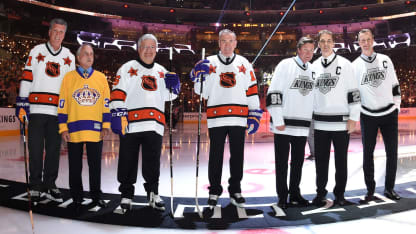
© Andrew D. Bernstein/Getty Images
Because of that shared sense of place, it almost felt like I knew Taylor better than the other players in my hockey card collection. Whenever I would leaf through my assortment of binders, which contained sheet after sheet of cards, I wanted to glean as much information about the players as I could. Beyond the their stat lines, I wanted to know where they were from and how they got to the NHL. More than anything, I wanted their stories.
This is probably why some of my favourite cards weren't even those of players, they were of the NHL's trophies. On the back of these cards in a text box not much larger than a postage stamp was the origin of the trophy and its namesake. I treasured those details. And while anyone who had a Dave Taylor card could clearly see he was from Levack, because of where my dad was from, it felt like I was privy to inside information and that made me feel like I was part of an exclusive club.
So when my parents explained to me that there was a good chance Taylor would be at the 35th anniversary party for Levack High School, where he and my father attended, I was ecstatic. I was actually going to be able to put a face and, hopefully an autograph, to my card.
I don't recall much about the celebration, but I do remember meeting Taylor. Sort of. The details are fuzzy but I know we were in the parking lot outside the Levack arena because I can still picture the gravel. I was probably wedging the toe of my shoe into the stones while my dad asked if we could get his autograph.
I had never met a hockey player in real life before. While Taylor looked unassuming in clothes no different from my father's, he looked, to me, like a hockey player. I couldn't put my finger on it, but there was a quiet confidence about him that drew you in. He had a presence. Although I probably felt differently about him a year later after he and the Kings vanquished my beloved Maple Leafs in Game 7 of the Conference Final, in that moment, he seemed like a larger than life figure to me.
After Taylor and my dad exchanged pleasantries, perhaps even a chuckle about ditching class to grab a pint at the local Blue Bird Tavern, he signed the back of the card and I dutifully tucked it back into my pocket. I may not have remembered much else from the encounter, but I know I cherished that card from that moment on. Nearly three decades later, I still have it.
It was only once I got older and better understood the game that I fully appreciated how exceptional of a player Dave Taylor was. Over his seventeen year NHL career, which was spent entirely with the Kings, Taylor played in 1,111 games, a franchise record that stood for more than two decades, while racking up 431 goals and 1,069 points.
Even after Taylor hung up his skates, he continued to have an impact on the club, becoming general manager in 1997, a position he held until 2006. During his tenure as GM, Taylor oversaw the revitalization of the Kings' development system, which included the purchase of an American Hockey League franchise and a different approach at the Entry Draft. Taylor's regime was responsible, most notably, for selecting Dustin Brown, Anze Kopitar, and Jonathan Quick, three players who would form a significant part of the Kings nucleus that would go on to win two Stanley Cups in three years.
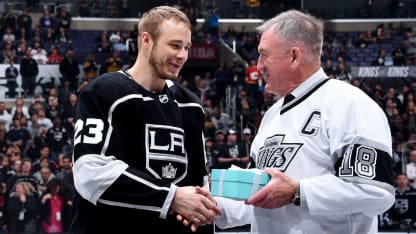
Taylor's impact on the Kings, both on and off the ice, was incredible, but it is even more impressive because of how improbable it all was. Only a few NHL players have come out of Levack and none went on to have the career Taylor had.
Nestled along the Canadian Shield, five hours north of Toronto, Levack is, at its core, a mining community. After the extension of the Canadian Pacific Railway line brought explorers and prospectors into the area in the late 19th century, minerals were discovered and excavation soon followed. For nearly the next hundred years, Levack remained a company town, operated by INCO, one of the largest nickel producers in the world.
For much of the 20th century, if you lived in Levack, you either worked underground or for one of the businesses that serviced the industry. That was how it was for the Taylor family and even my own. Taylor's father worked in Levack Mine and, across the way, in Onaping, my grandfather, Frank, an Italian immigrant, worked for the other mining company, Falconbridge. While mining was a good way to earn a living in Levack, Taylor's father didn't want him to follow him underground. He wanted more for his son. He wanted him to get an education. Hockey would provide both.
After playing all of his minor hockey in his hometown, Taylor was not drafted to major junior. Instead, after receiving some interest from a few colleges, Taylor accepted the only serious offer and went off to Clarkson University. There, under the tutelage of future Hall of Fame coach Jerry York, Taylor would establish school records for career and single season totals in all offensive categories. Following his sophomore season at Clarkson, he was selected 210th overall by the Kings at the 1975 NHL Amateur Draft. There were only seven players taken after him.
After finishing his collegiate hockey career, which included a sterling 108-point season, Taylor cracked the Kings roster out of training camp, but a trade early into 1977-78 campaign had him in and out of the press box.
Halfway into the season, Taylor got a significant opportunity when head coach Ron Stewart put him on Marcel Dionne's line. The two immediately clicked and Taylor picked up 33 points in the club's remaining 41 games that season. The following year, the pair would be joined by Charlie Simmer, forming the Triple Crown, one of the best lines in NHL history. The rest, as they say, is history.
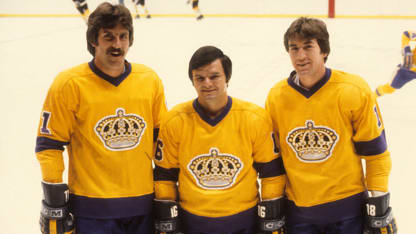
When Taylor reflects on his unlikely journey, he thinks of his career as a series of opportunities to prove himself. He believes the first one came when Clarkson head coach Jerry York unexpectedly showed up at the Levack Arena.
"I came out of the locker room and he was waiting there to talk to me," Taylor said.
"He said 'I'm Jerry York from Clarkson University and I'd like to come over to your house and talk to you and your parents about coming to Clarkson.'"
Taylor remembers York giving him a dime so he could go to the pay phone and call his parents to let them know he was coming home and he was bringing somebody with him.
At the time, Taylor was in his final year of high school and was just hoping to get into a Canadian university and continue playing hockey. He had received a few letters of interest from some schools in the United States, but nothing firm. York, on the other hand, wanted him to come and play for him and the Golden Knights.
York had just finished his first season behind the bench at Clarkson. In 1972, at just the age of twenty-six, York had been named head coach and now he was hoping to make Taylor part of his first recruiting class.
By the time York had finished his pitch at the family kitchen table, the Taylors had heard everything they needed to hear. "He chatted with my mom and dad for quite a bit and they loved him," Taylor said.
"He asked my dad, what he thought and my dad said 'I'd like my son to get an education.' And they shook hands and that was it."
It meant a lot to Taylor that York had made the trek to come and see him. "The one day that Jerry York was there turned out to be the biggest break of my hockey career," Taylor said.
It was a move that would work out well for both of them. Forty-six years later, during his Hockey Hall of Fame induction speech, York reflected on Taylor, his first recruit, and sitting down with his family in Levack where it all started. After coaching at Clarkson, York went on to Bowling Green and Boston College, a journey that would make him the winningest coach in NCAA hockey history.
When Taylor arrived at Clarkson, he was 5-foot-9 and a measly 130 pounds. He figures that he went undrafted at the junior ranks because he was undersized at the time.
"I was a late bloomer," Taylor said. "I probably grew two or three inches my freshman year and put on 15 pounds or so and gradually added to that over the four years."
After having a solid rookie season, putting up 30 points in 25 games, the budding Taylor recorded 20 goals and 54 points in his sophomore campaign.
When he returned home that summer, Taylor took a job underground to make some money to bring back to school. Working at Levack West Mine, on the other side of the river from Levack Mine, where he had worked the previous summer, Taylor was on the blast crew.
At the end of the shift, his crew were the last ones to leave the mine. They would light their fuses on the explosives they had prepared that day and then carefully make their ascent after detonation.
One day in June that summer, Taylor received an unexpected phone call at home from his sister, Linda.
"She worked at the credit union in Levack and one of her co-workers was going through the newspaper," Taylor said.
"He asked where I went to school and after she told him I was at Clarkson, he said 'he got drafted by the LA Kings.' So my sister called the house and told me I got drafted."
The Kings had taken him in the 15th round.
Taylor was excited about the direction his hockey career was taking, but he still had a job to do before returning to college. When he showed up for his next shift underground, his foreman, having heard the news, stopped him.
"The shift boss, Mr. Murphy, said to me, 'Taylor, they didn't give you a wheelbarrow full of money to stay out of mines?'" Taylor recalled with a laugh. "I said 'no, I don't think they do that for 15th round draft choices. I'll be here all summer." And he was.
Taylor took his hard rock work ethic back with him back to Clarkson. He continued to improve and, in his junior year, he picked up 59 points. But it was his final year with the Golden Knights that he really got the Kings' attention. In that final campaign, Taylor scored 108 points in 34 games, setting school records that still stand.
Following Taylor's record-setting season, the Kings inked him to his first professional contract. By summer's end in 1977 he would be at his first NHL training camp.
It was a surreal experience for Taylor. Just a couple summers earlier he was working underground, helping to set explosives, and now he was a professional hockey player plying his trade out in Southern California.
Levack was a long way from Los Angeles, but Taylor didn't have many opportunities to soak it all in. During the first week of camp, it was so difficult that there was little time for much else other than hockey.
"We'd have a practice in the morning and they'd skate the heck out of you," Taylor said.
"Then you'd go back to the hotel across the street from the Forum and have lunch and then go back to the rink for an afternoon scrimmage. A lot of time on the ice and a lot of work. It was exhausting."
Taylor made an impression and made the regular-season roster out of camp. Although he earned his position with his strong play, Taylor couldn't help but think he wouldn't have had the opportunity if the club hadn't taken a chance on him in the draft.
"The Kings took a flyer on me," Taylor said. "The scout most responsible was a guy named Alex Smart. He lived in Ottawa and was at a lot of Clarkson games. He took a chance on me and I got to earn a spot in LA and work my way up."
Despite standing out at camp, Taylor still remained on the bubble and spent his first three months living in Los Angeles at the Airport Park Hotel. When the team finally told him he should look for a place, he rented an apartment in Marina del Rey with one of the team's trainers, Rob Ricard.
Taylor made his NHL debut on October 12, 1977, the Kings' first game of the season. He doesn't remember much from that contest, a 2-0 victory at home against the Cleveland Barons, but he does remember his first goal.
Later that month, in the fifth game of the campaign, the Kings hosted the Bruins. Late in the second period, Boston was leading 3-1 when Taylor made his way towards goaltender Gerry Cheevers.
"I was in front of the net," he said. "It was a point shot and it went off my skate and up into the top corner. It counted."
Despite picking up a goal and an assist in his first five games, Taylor found himself spending most of his time on the fourth line, flanking centers Vic Venasky or Pete Stemkowski. After the Kings traded Dave Schultz and Gene Carr to the Penguins for Syl Apps and Hartland Monahan on December 16, 1977, the club had a glut of righthanded shot forwards and Taylor, a rookie right winger, found himself watching some of the team's games from the stands.
Following an injury to Monahan, however, Taylor returned to the lineup and became a regular again. A few week later, he capitalized on another opportunity. On January 7, 1978, on the road against the Penguins, head coach Ron Stewart moved Taylor up to Marcel Dionne's line.
"We were out on the road and we weren't doing very well, so he put me up on a line with Dionne," he said. "We kind of connected. We had chemistry and played well together. From that point until the end of the year, I basically played on the Kings' first line."
Much like getting a visit from Jerry York years earlier in his hometown, Taylor viewed the promotion as another stepping stone. "That really helped my career take off," he said.
Although Taylor made the most of that opportunity, he had earned it with how he played the game. While he wasn't big by hockey standards, he was strong and tough to get off the puck.
There were few players in the league who relished going into the corners more than Taylor and digging pucks out for their teammates. A two-way player, skilled on both sides of the puck, Taylor was utilized in nearly every situation. Whether it was on the power play, penalty kill, or protecting a lead late in a game, Taylor was the type of player a coach would want to throw out onto the ice.
In his second season, Taylor continued playing on Dionne's wing. Halfway through the year, on January 13, 1979, the pair were joined by Charlie Simmer, who was recently called up from the Kings' American League affiliate, the Springfield Indians.
The trio immediately clicked and formed what would become known as the Triple Crown Line, one of the most prolific units in NHL history. Taylor, who finished his rookie season with a commendable 43 points, had followed that up with an impressive 91-point campaign.
In the 1980-81 campaign, Taylor's fourth in the league, the Triple Crown Line dominated the NHL and combined for 328 points. By season's end, each player had racked up more than 100 points, marking the first time in NHL history that a line had each player score 100 points or more in the same season.
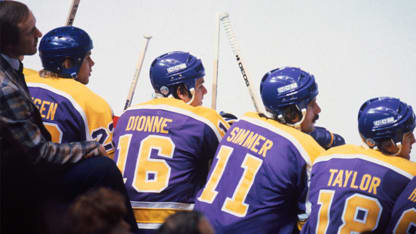
Over the years, Taylor has been asked countless times about what made the Triple Crown Line so productive and, for him, it still comes down to how he and Simmer were able to complement Dionne's incredible skillset.
"He was one of the best players I've ever seen, playing with or against in NHL history. I think Charlie and I had some components that could complement him," he said.
"I like to think of myself as a two-way player who could forecheck and dig pucks out of the corner and get them out to Marcel," Taylor continued. "Charlie had an unbelievable knack around the net. He was a great big guy, he was hard to control. He had great hands. Probably the best I've ever seen at screening the goalie and getting his stick on pucks for deflections and rebounds."
The Triple Crown Line stayed together until Simmer was traded to the Bruins on October 24, 1984. A few years later, Dionne was dealt to the Rangers, but Taylor remained. He continued to be an important part of the Kings until he sustained a series of concussions in the 1992-93 season.
"I got a real bad one that year," he said. "I lost my helmet and hit my head on the ice. I was not right for about a month. I had a really hard time with that."
Limited to just 48 games that year, Taylor was in and out of the lineup that season. After missing most of the club's games in February, he returned in mid-March and remained healthy enough to play throughout the Kings' deep playoff run.
By that point, Taylor had been with the club for sixteen years, and had accomplished more with the Kings than any other player, but that post-season run topped it all.
"The highlight for me is still getting to the Stanley Cup Final in 1993," he said. "We won a terrific Game 7 in Toronto to go to the Final. Just to have the opportunity to go to the Montreal Forum and all the history there and skate out on the ice with the Stanley Cup at center ice." Although the Kings came up a few wins short, it was something Taylor will never forget.
Taylor returned the following season but he couldn't shake the effects of his concussions. After running into linemate Warren Rychel following a faceoff in a game against the Nordiques on January 4, 1994, Taylor sustained another concussion.
During the previous season when he suffered a few concussions in a short period of time he noticed how once his symptoms subsided, and he was healthy enough to play again, it didn't take much for them to return. As a result, Taylor was really concerned about his future off the ice.
A few months later, still unable to play, Taylor made the decision to retire. It was the end of an era. Not just for the Kings, but for the sporting landscape in Los Angeles. When Taylor made his announcement, only Bill Russell, who suited up for 18 years with the Dodgers, and Jackie Slater, who spent 19 years as an offensive tackle with the Rams, could top his 17 years with the Kings, for the most with a pro sports team in LA.
But before Taylor hung up his skates for good, he made one final appearance with the club. In the Kings' last game of the regular-season, Taylor was on the roster.
Although he didn't play that night, he suited up and took to the ice for a ceremonial faceoff against the visiting Oilers. After winning the draw and passing the puck over to Luc Robitaille, play was stopped and Taylor received a roaring ovation from the home crowd and some raucous stick taps from both teams.
After skating back to his bench and shaking hands with all of his teammates, Taylor returned to the dressing for the final time with a Kings jersey on his back. No one had worn that uniform more times than he had and it would take nearly a quarter century before someone else eclipsed his mark.
While it is never easy to leave the game, Taylor had no regrets about his decision. "I always felt fortunate that I got to play as long as I did and got to play that many games in LA and with one team," he said.
"I played with a lot of great players. I played with Dionne, Simmer, Gretzky, Robitaille, Rob Blake, Larry Robinson, and Rogie Vachon. I look back on it and think I was very fortunate."
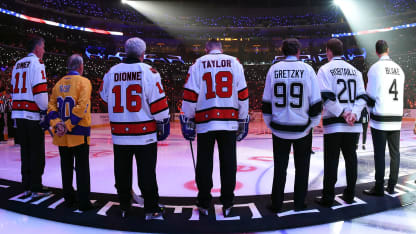
Although his playing career with the Kings had come to an end, Taylor was ready to start a new chapter with the club. Not long after retiring, he was hired as the Kings' assistant to the general manager. Working with GM Sam McMaster, Taylor learned the ins and outs of the front office.
"When you're a player, you just have to worry about one guy getting ready for the game," he said. "When you go upstairs and you see everything involved in a hockey club, it's pretty overwhelming but I learned a lot from Sam, particularly on the hockey side."
A couple of years later, after the Kings emerged from bankruptcy, Taylor became the club's new general manager. While his predecessor was often hamstrung by the team's precarious financial position, Taylor took the reins early into the Anschutz ownership era.
"Sam had to make some tough decisions because we didn't any money. He didn't have any money to chase free agents," Taylor said. "There were a couple of players we had drafted and we couldn't afford to sign them, so we ended up letting them become free agents."
Unlike McMaster, Taylor would have the necessary resources at his disposal to help rebuild the Kings. One of his key priorities was to improve the club's player development strategy.
"We went out and bought an American Hockey League franchise and put it into Manchester, New Hampshire," he said. "I think that really improved the infrastructure of the team."
Taylor also took a different philosophical approach to development.
"When I first joined LA as a player, Jack Kent Cooke was the owner and he loved to trade away first-round picks and the Kings had just not grown a lot of their own players," he said. "Probably why a guy like me, drafted in the 15th round, got the chance to play right away," Taylor added with a laugh.
For Taylor, it was vitally important for the club to hold onto its picks and improve at drafting.
"We didn't have a lot of prospects in the system," he said. "We had had a history of trading away a lot of high draft choices, but we stopped that and got the team going in the right direction."
Nothing exemplifies this better than Taylor and the Kings' selections at the 2003 and 2005 NHL Entry Drafts. In 2003, the club selected Dustin Brown, the player who would break Taylor's franchise record for most games played, 13th overall. Two years, the Kings took Anze Kopitar 11th overall and plucked goaltender Jonathan Quick in the third round.
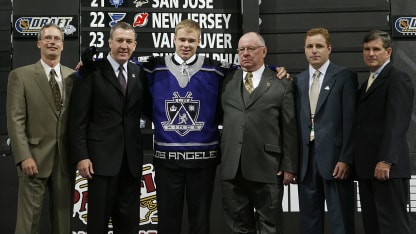
Although Taylor did not stay with the club long enough to see them mature into the players they are today, he still takes a lot of pride in knowing that he played an important role in their development.
Kopitar, in particular, stands out for Taylor. "We did our homework on him," he said. "It was a little scary taking a guy from Slovenia with your first pick but we absolutely thought it could be a home run for the Kings and that's how it turned out. He's been absolutely terrific ever since he stepped into the league."
After the Kings won the Stanley Cup in 2012, with all three of those players each playing a critical role, Taylor recalls getting a call from the club's head pro scout, Rob Laird. "He called me up and said 'Dave, your name is not on the Cup but your fingerprints are all over it,'" he said.
While Taylor appreciated Laird's words, he still hoped there would be a day when he would have more than just his fingerprints on the trophy. In 2019, after nearly ten years as the St. Louis Blues' Vice President of Hockey Operations, Taylor finally got his name etched onto Lord Stanley's mug.
When it came time for Taylor to decide on his day with the Cup, he thought about bringing it to Levack, Clarkson University, and Los Angeles. But after Blues GM Doug Armstrong told him he could only pick one location, Taylor knew it had to be Levack.
Finally after 42 years in the @nhl as player and management @StLouisBlues Vice president of Hockey Operations Dave Taylor brings home the #stanleycup to Levack just north of Sudbury. @HockeyHallFame pic.twitter.com/wiTzykc2HX
— Philip Pritchard (@keeperofthecup) July 11, 2019
"That's where I grew up, that's where my hockey fundamentals were developed," he said.
Almost fifty years after Jerry York showed up in the small mining town to offer him a scholarship, Taylor was back with hockey's ultimate prize.
It may have taken him a little longer than he would have liked, but he wouldn't have changed the journey. After starting his hockey career on the outdoor rink in his hometown, Taylor got to live out a childhood dream and returned home to a hero's welcome.



